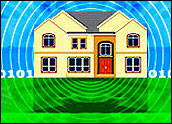
U.S. residential broadband Internet penetration has grown more than 400 percent since 2002, when just 16.5 million U.S. households had fast Internet service, according to Parks Associates. The increased presence of these high-speed connections has implications for a variety of devices, which increasingly are arriving in the home with embedded connectivity capabilities.
At present, connected appliances amount to less than 1 percent of all major appliances in the U.S.; however, many different types of firms are developing products and services to capitalize on the emerging home controls and management market.
As is typical of a market in its early stages, it is very fragmented. Companies are designing their solutions to meet market needs and drive change, but overall, there’s a set of different objectives that need to be aligned to realize full success in the connected home.
Interoperability Is No. 1
In order for devices to communicate and work together in the home, interoperability must be achieved. It’s essential not only between different networks, but also between applications — where the precise language used to communicate to each device is defined — and at the service layer, where the details of the network and the devices in that network are communicated.
The critical first step in developing a connected home strategy involves both short- and long-term business objectives for connected products. Companies in this market must understand the competitive landscape and technology options, set goals both to differentiate their own services and integrate with other products, and take steps to enhance their relationship with customers in order to succeed in a way that will help the market grow.
Who Does What
That initial step requires, in part, understanding the role of the different companies involved in the design, development, and deployment of a connected solution. Each layer of the communication stack — including home area networks, gateways, services and applications — is comprised of different products playing a role in interoperability that must be addressed by suppliers, manufacturers and vendors.
- Connected device manufacturers develop a wide range of products located in or around the home. Utility meters, thermostats, appliances, lighting controls, power plugs and security components are being connected to the home area network. As the cost of adding connectivity falls, and as capability and user experience improve, more and more end devices will be connected to the network.
- Home area network technology suppliers develop technology that enables devices to connect to the Web, whether they are individual products or an ecosystem of connected products that work together. These technology suppliers enable different device manufacturers to add connectivity to products and enter into an ecosystem of interoperable products that utilize the same network technology.
- Gateway technology suppliers develop technology that enables devices from multiple home area networks to connect to a single gateway. The gateway provides a method to connect, communicate with, and control the devices in the home. Gateway middleware vendors and standards development organizations are working to abstract the details of connected devices that use different home area network technologies so that from the perspective of the application developer, the interface to that device is uniform.
- Gateway-based home control platform vendors have developed systems that allow users to commission and operate the devices inside the home. The software platform includes a method to add new devices to the system and control the devices in the home. The control function may be basic on/off, complex event-driven automatic control, or advanced learning-based control. The gateway-based software platform is usually connected to a cloud-based portion that provides remote control and monitoring functionality.
- Cloud-based home control platform companies provide a system that connects the hardware in the home to the cloud and creates a virtual object that mirrors the functionality and control of the real object in the home. Cloud-based platforms differ from gateway-based platforms in that the gateway is treated mostly as a pass-through device with no or limited local control capability.
- Big Data and data analytics vendors provide a distributed architecture for hosting data and advanced analytics tools. The data and analytics tools can be used to mine data to gain product and user insights, develop models on the home environment and behavior, provide advice and recommendations, and integrate with other data sources to provide advanced control applications.
- Application developers provide applications that connect to an individual or group of devices and allow users to remotely monitor and control those devices using a computer, smartphone, tablet or connected TV. Applications may also perform provisioning and control of new devices added to the network. More-sophisticated applications will automatically control devices in the home based on events, including lifestyle events and external events, like a change in energy pricing or a shift in the outside temperature. Events can be programmed or learned.
- Interoperability technology providers are working to achieve interoperability by developing standards that many vendors can use to communicate between devices. Standards can cut across applications, data, platforms and home area networks, or they may involve a single layer. Application interoperability solutions, for example, focus on a solution to integrate many devices into a home control solution. Several groups are working to develop open industry standards that simplify the connectivity and usability of devices and services within the home. Common interfaces to virtual objects will allow a single application to bridge together different devices and networks, and allow them to work together.
Companies in the connected home space must begin to align business objectives with each other. In the end, the business models that reward innovation, that are open, and that are fully interoperable at all levels are the ones that will be successful. The Internet of Things will come into being only when the interoperability challenges are conquered.












































Social Media
See all Social Media